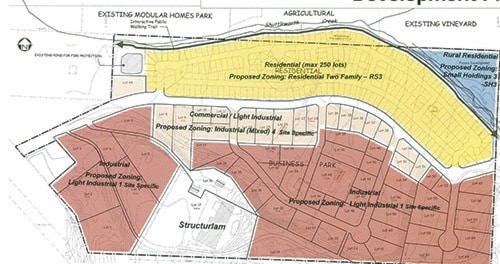A well known development proposal for the former Weyerhaeuser property in Okanagan Falls appears poised for oblivion.
A single sentence in the newly revised Official Community Plan for the region appears to discourage a portion of the proposal - and developer Jim Morrison of Penticton told the board at the July 4 meeting that he “was done” with his proposal after discussing it with the directors last Thursday.
Morrison said that he assumed he and his partners would be invited to participate in the OCP revisions that took place over the past several months in area D-2, which comprises the portion of regional district Area “D” east of Skaha Lake.
Instead, Morrison said that a “parallel process” went on, where the OCP was developed without any thought to his project.
In 2009, Zinfandel - Morrison’s company proposing the development - released a concept plan designating three main uses for the property, including commercial/industrial, affordable housing and a potential vineyard.
However, the project had been on hold until last November, when a Certificate of Compliance from the provincial government specifying the site had been remediated to meet environmental quality standards was finally provided.
Morrison approached the board because of his concern that the OCP, in its present wording, could interfere with his proposal to move the Weyerhaueser lands forward. The document was also on Thursday’s agenda for first and second reading prior to going back to the public for public hearing,
Morrison conducted his own open house in early June, sending 197 mail outs to inform residents of issues surrounding the OCP wording and his development. He told the board that his findings held that 81 per cent of those polled supported the development with its residential component.
The issue of contention concerned the residential lots fronting Shuttleworth Creek. Morrison said the development proposal was not profitable without the residential component. He asked the board to soften or remove entirely a sentence in the OCP (page 53, 13.2-2) that stated that the regional board “Recognizes the importance of maintaining the industrial land base, including the former Weyerhaeuser site and discourage the conversion to other non-industrial uses.”
“This development contains 155 acres, there’s 140 more in Okanagan Indian Band land (Senkulmen Enterprise Industrial Park near Oliver).The absorption of industrial lands will take decades.
I don’t want to fight anymore - I’m done. I’ve put three years of my life into this - I feel like I’ve been whacked in the head,” he admitted to the board.
Morrison noted that his development contained affordable housing - units of $240,000 or less - that were projected to take 20 years to completely sell off. He asked why he and his partners had not been invited to participate in the OCP discussions as a stakeholder. As Morrison’s arrangement with Weyerhaeuser has not yet involved the sale of the land, it was likely the company was made aware of the OCP proceedings.
Morrison said he had invested $300,000 on the development to date, and had received nothing but positive input and assurances from the regional district from both present director Tom Siddon and former director Bill Schwarz. (As recently as November, Siddon was quoted in the Penticton Western as saying, “We have high hopes to get this project going forward. It was fundamentally important to economic development after the closure of the mill, about four years ago, to get those lands converted to some other, higher value use, hopefully to create permanent, year-round jobs.”)
Following Morrison’s pitch to the board, the directors gave first and second readings to the OCP, allowing it to proceed to public hearing.
Area “D” Director Siddon urged patience on the issue, noting that the contentious sentence was a general statement that allowed lots of latitude.
